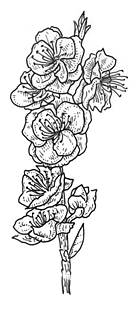Synonyms: Pygeum APNI*
Amygdalus APNI*

Description: Trees or shrubs, mostly deciduous, flowers usually appearing in spring before the leaves. Stipules absent.
Flowers perigynous. Petals usually pink or white. Stamens 20–30. Carpel solitary, seated in the cup-shaped hypanthium; ovules 2 per carpel but becoming 1 by abortion.
Drupe usually fleshy and edible, often furrowed on one side, 1-seeded.
Distribution and occurrence: World: c. 430 species, cosmopolitan, mainly northern temperate. Australia: >10 species, (all but 1 species naturalised), Qld, N.S.W., Vic., Tas., S.A., W.A. [including Amygdalus, Cerasus, Laurocerasus, Padus and Pygeum]
Many species are cultivated in cooler climates for their fruits or as ornamentals. Some species have become established along roadsides after the seeds have been discarded; rarely fully naturalised. Prunus has previously been placed in family Amygdalaceae.
Text by G.J. Harden & A.N. Rodd, Flora of New South Wales Vol. 1 (1990); last revised May 2017 (PGK)
Taxon concept: Australian Plant Census (accessed May 2017)
Taxa not yet included in identification key
Prunus avium,
Prunus campanulata,
Prunus domestica
| | Key to the species | |
| 1 | Fruit mostly more than 15 mm diam., usually furrowed on one side, usually pruinose, sometimes pubescent; terminal bud present or absent; flowers 1–3, appearing before the deciduous leaves | 2 |
| Fruit mostly less than 15 mm diam., neither furrowed nor pruinose; terminal bud present; inflorescence many-flowered, either a raceme more than 6 cm long or flowers in more or less umbel-like clusters; either leaves not deciduous or flowers appearing after leaves have developed | 5 |
| 2 | Flowers and fruits on pedicels more than 5–15 mm long | 3 |
| Flowers and fruits more or less sessile
Back to 1 | 4 |
| 3 | Petioles without glands; margins of leaves evenly and regularly toothed, teeth more or less acute; flower buds not enclosed in conspicuous brownish bracts | Prunus cerasifera |
| Petioles with glands; margins of leaves doubly toothed (teeth of 2 sizes), larger teeth more or less obtuse; flower clusters enclosed in conspicuous brownish bracts in bud, these persisting around flower pedicels
Back to 2 | Prunus cerasus |
| 4 | Leaves oblong to more or less lanceolate; petiole often with glands near apex; stone deeply pitted and furrowed | Prunus persica |
| Leaves broad-ovate to more or less circular; petiole without glands; stone smooth with a thickened furrowed edge
Back to 2 | Prunus armeniaca |
| 5 | Glands usually present on petioles; deciduous plants | 6 |
| Petioles without glands; evergreen plants
Back to 1 | 8 |
| 6 | Flowers in umbels; margins of leaves doubly toothed, larger teeth more or less rounded | Prunus cerasus |
| Flowers in racemes; margins of leaves regularly and finely toothed, teeth similar in size
Back to 5 | 7 |
| 7 | Leaves usually more than 5 cm long, oblong-elliptic to obovate; teeth acute | Prunus serotina |
| Leaves usually less than 5 cm long, broad-ovate to more or less circular; teeth rounded
Back to 6 | Prunus mahaleb |
| 8 | Margins of leaves crenate-toothed; racemes exceeding leaves | Prunus lusitanica |
| Margins of leaves remotely small-toothed, sometimes more or less entire; racemes shorter than leaves
Back to 5 | Prunus laurocerasus |
|


